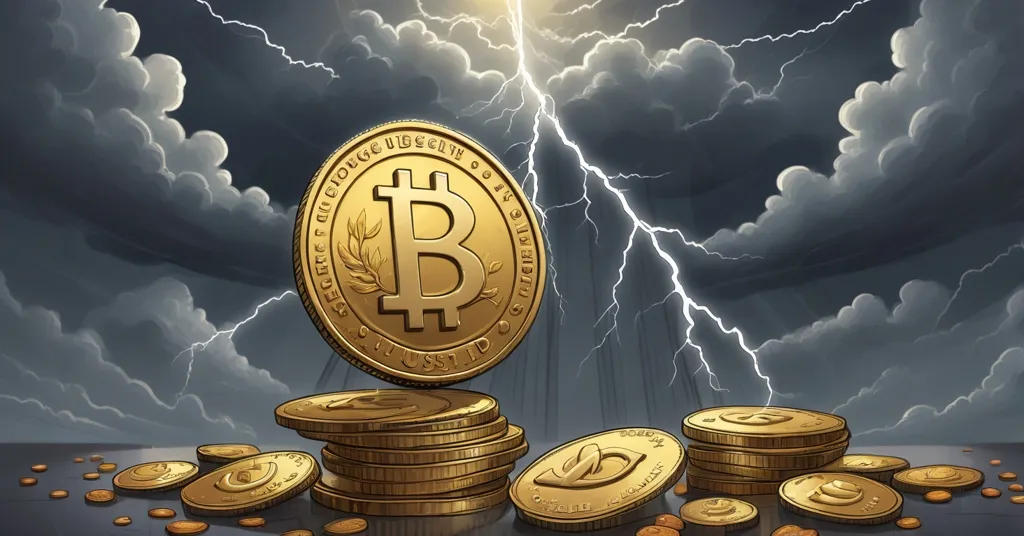Tether (USDT) Under Siege: Regulated Stablecoins USDC, RLUSD Threaten Dominance Amid Crackdown

Tether (USDT) Faces Existential Threat: Regulated Stablecoins Like USDC and RLUSD Gain Ground Amid Regulatory Firestorm
Tether (USDT), the juggernaut of the stablecoin world with a staggering $156 billion market cap, is teetering on the edge as regulated competitors like Circle’s USDC and Ripple-backed RLUSD close in, armed with compliance credentials and institutional trust. With global regulators clamping down and Tether making a gutsy call to ditch support for five blockchains by 2025, the road ahead for this digital dollar titan looks more like a gauntlet than a victory lap.
- Transparency Black Hole: Tether’s refusal to fully disclose reserves fuels distrust, driving big players to safer rivals.
- Regulatory Vice Grip: EU’s MiCA and US GENIUS Act threaten to sideline USDT in major markets.
- Blockchain Cull: Dropping five networks risks stranding users with frozen funds if they don’t act by September 2025.
- Fighting Chance: Unregulated markets and geopolitical leverage offer Tether a lifeline, but for how long?
Stablecoins 101: Why Tether’s Role Is Both Vital and Vulnerable
For those new to the crypto game, stablecoins are digital tokens pegged to real-world assets like the US dollar, designed to keep a steady value amid the rollercoaster of Bitcoin and altcoin prices. Picture them as digital dollar bills you can use in the chaotic marketplace of crypto trading—a safe haven when volatility hits hard. They’re the backbone of Decentralized Finance (DeFi), which are blockchain-based financial systems that cut out traditional middlemen like banks, and a crucial link between old fiat money and the new digital frontier.
Tether’s USDT reigns as the heavyweight champ, dwarfing rivals with its market cap and powering trading volumes on platforms like Binance, especially in regions like Asia and Latin America where over 95% of its supply operates on networks like Ethereum and Tron. But being the biggest doesn’t make you bulletproof, and Tether is finding itself in the crosshairs of regulators, competitors, and its own murky history, as detailed in its long-standing controversial background.
Tether’s Transparency Mess: A Scandal That Keeps Haunting
Let’s not sugarcoat it: Tether’s biggest problem is that it plays fast and loose with trust. For years, the company behind USDT has been hammered for refusing to lay bare the assets backing its tokens—the supposed cash and investments guaranteeing every USDT equals one dollar. Back in 2021, a brutal investigation by the New York Attorney General uncovered that Tether had flat-out lied about its reserves to cover an $850 million loss tied to its affiliate exchange, Bitfinex. The fallout? A measly $18.5 million fine and a reputation stain that still reeks. Half-hearted audits and attestations since then haven’t done much to clean the slate. Why the hell should anyone stake billions on a company playing an endless game of “just trust us”? You can explore more about these reserve backing concerns that continue to plague Tether.
For us Bitcoin maximalists, this centralized nonsense is a glaring reminder of why Bitcoin’s trustless, transparent design is the real deal. Tether’s opacity isn’t just a PR disaster—it’s a red flag for institutions and regulators who want hard proof, not promises, before they play ball.
Regulatory Reckoning: MiCA and GENIUS Act Tighten the Noose
The heat isn’t just coming from bad press; global regulators are turning the screws. In the European Union, the Markets in Crypto-Assets Regulation (MiCA) is a game-changer—a strict rulebook for digital assets rolling out fully by late 2024 for stablecoins. It demands regular reserve audits, e-money licensing, and anti-money laundering (AML) compliance. Circle’s USDC got the stamp of approval, while Tether has been effectively kicked to the curb in the EU market. That’s a massive blow, signaling to the world that non-compliant players need not apply in one of the largest economic zones. Learn more about the effects of MiCA on stablecoins and how it’s reshaping the landscape.
Over in the US, the proposed GENIUS Act—part of broader stablecoin legislation still under debate in Congress—ups the ante. It calls for full audits, robust AML programs, and user verification through Know Your Customer (KYC) protocols. If Tether doesn’t comply, it could be forced out of the US entirely. CEO Paolo Ardoino has floated the idea of launching a separate, compliant stablecoin for the American market, but let’s be real: that’s a bureaucratic minefield with hefty costs and no guarantee of success. And then there’s the ugly side—reports of USDT being used for illicit activities like sanctions evasion by actors in Russia and North Korea keep regulators’ eyes locked on Tether. Yeah, they’ve frozen $23 million tied to shady exchanges recently, but the stench of suspicion isn’t going anywhere fast, as discussed in various community debates on Tether’s regulatory challenges.
Regulated Rivals Rising: USDC, RLUSD, and the New Guard
While Tether stumbles under scrutiny, competitors are pouncing. Circle’s USDC, with reserves of 100% cash and short-term US Treasuries as per recent audits, is the poster child for compliance, gaining serious traction in the US and EU. Then there’s RLUSD, backed by Ripple’s infrastructure, alongside players like PYUSD (PayPal’s stablecoin) and USDG, all flaunting high-quality, liquid reserves that make institutional investors drool. For a deeper look at how these two giants stack up, check out this comparison between Tether and USDC. Crypto researcher SMQKE didn’t pull punches on the threat:
“Tether will lose market dominance to regulated stablecoins like the RLUSD in the future.”
True, USDC’s supply still lags far behind USDT, but regulatory tailwinds give it an edge in markets that matter to big money. A recent report captured the uncertainty perfectly, and you can read more on how Tether’s dominance is slipping to regulated competitors.
“Only time will tell whether Tether will continue to leak market share to rivals or continue to hold sway with cryptocurrency fans.”
But let’s play devil’s advocate: are these newcomers ready to topple a titan like Tether, or is this just compliance hype masking their smaller scale? USDT’s sheer volume and ecosystem integration aren’t easy to replicate overnight.
Tether’s Blockchain Purge: A Bold Cut With Sharp Edges
As if regulatory woes weren’t enough, Tether dropped a bombshell by announcing it’s pulling USDT support from five blockchains—Omni Layer, Bitcoin Cash’s Simple Ledger Protocol (SLP), Kusama Network, EOS Network, and Algorand—effective September 1, 2025. This isn’t a random purge; it’s a calculated shift to focus on scalable, high-traffic networks like Ethereum, Tron, and Layer 2 solutions (technologies built atop base chains to make transactions faster and cheaper, such as Bitcoin’s Lightning Network). Ardoino laid out the reasoning without fluff, and you can find further details on this blockchain discontinuation decision.
“Sunsetting support for these legacy chains allows us to focus on platforms that offer greater scalability, developer activity, and community engagement — all key components for driving the next wave of stablecoin adoption.”
It makes sense on paper. Omni Layer, a key player in Tether’s early days since its 2014 debut as Realcoin, is now a ghost town with barely any developer buzz. EOS and the others? They’re relics compared to Tron, which handles the lion’s share of USDT transactions. Why sink resources into dead ends when the blockchain game is all about efficiency and scale?
Here’s the catch, though: users holding USDT on these doomed chains must migrate to supported networks or redeem their tokens before the deadline. Ignore the warning, and your digital dollars turn to worthless dust—Tether will freeze what’s left. Sure, they’ve advised using bridges or exchanges to shift tokens, but not everyone’s a crypto ninja. Some poor souls will miss the memo, and even if just 1% of holders on these chains sleep on this, we’re talking potentially millions in frozen funds. That’s not stability; that’s a sucker punch. For those questioning the safety of holding USDT, there are plenty of insights on risks associated with Tether.
Can Tether Survive? A Playbook Fraught With Risks
So, does Tether have a shot at holding its throne? Its iron grip on unregulated markets—think Binance-driven trading in Asia and Latin America—gives it a buffer that compliant rivals can’t match yet. There’s also a sneaky geopolitical angle: Tether’s massive holdings of US Treasury bills, a form of government debt, reportedly make it a player in supporting US debt management. Could that buy some leniency from US regulators instead of a full ban? It’s a wildcard, but don’t bet the farm on it.
Looking forward, Tether might roll out a “USDT 2.0” for the US, fully compliant with audits and KYC rules. Or it could lean harder into DeFi integrations to lock in user loyalty. But here’s the rub: will a sanitized Tether lose the renegade vibe that made it a crypto darling? And let’s not mince words—compliance comes with costs and complexity that could bog down operations. For us cheering decentralization, stablecoins like USDT are a necessary stepping stone to a Bitcoin-driven future, but their centralized baggage proves why BTC’s trustless model remains unmatched. For more on how regulations like MiCA are affecting stablecoins like USDT versus USDC, dive into these compliance updates.
Key Questions and Takeaways on Tether’s Shaky Ground
- What’s behind the threat to Tether’s stablecoin dominance?
Tether’s long-standing refusal to fully disclose its reserve backing, coupled with crushing regulatory pressure from frameworks like the EU’s MiCA and the US GENIUS Act, is pushing institutions toward compliant alternatives like USDC and RLUSD that prioritize transparency and legal alignment. - How are global regulations changing the stablecoin landscape?
New rules are setting a high bar—stablecoins must prove reserves and comply with strict oversight, boosting regulated players like USDC while squeezing Tether out of key markets like the EU, with the US potentially next if it doesn’t adapt. - Why is Tether abandoning support for certain blockchains, and who’s at risk?
Tether is cutting ties with five underused networks to prioritize scalable giants like Ethereum and Tron for efficiency. Users on chains like Omni Layer and EOS face losing funds if they don’t migrate or redeem tokens by September 1, 2025—a brutal lesson for the unprepared. - Does Tether stand a chance at maintaining its lead?
It’s a toss-up. Tether’s stronghold in unregulated regions and potential leverage with US Treasury holdings provide some armor, but without real transparency reforms, it risks fading in Western markets as rivals snag institutional trust. - What steps should USDT holders take to safeguard their assets?
If you’re holding USDT on affected blockchains, move fast—migrate tokens to supported networks like Ethereum or Tron, or redeem them through exchanges as Tether recommends. Miss the 2025 deadline, and your holdings are toast.
The Bigger Battle: Decentralization vs. the Regulatory Beast
Tether’s struggle isn’t just about staying on top—it’s a snapshot of crypto’s existential clash. Sure, regulation might “protect” users, but at what cost to the freedom and disruption we’re fighting for? Shoving stablecoins into the fiat system’s straitjacket risks killing the rebellious spirit of this space. Yet, as champions of decentralization, we can’t deny stablecoins are vital bridges to a Bitcoin-centric future—flaws be damned. If Tether trips, the shockwaves could rattle Bitcoin trading pairs and DeFi liquidity, showing that even in a decentralized dream, centralized weak spots can bite hard. So, will Tether morph into a compliant giant without losing its edge, or will it crumble under its own weight? Which horse are you backing in this high-stakes race?



